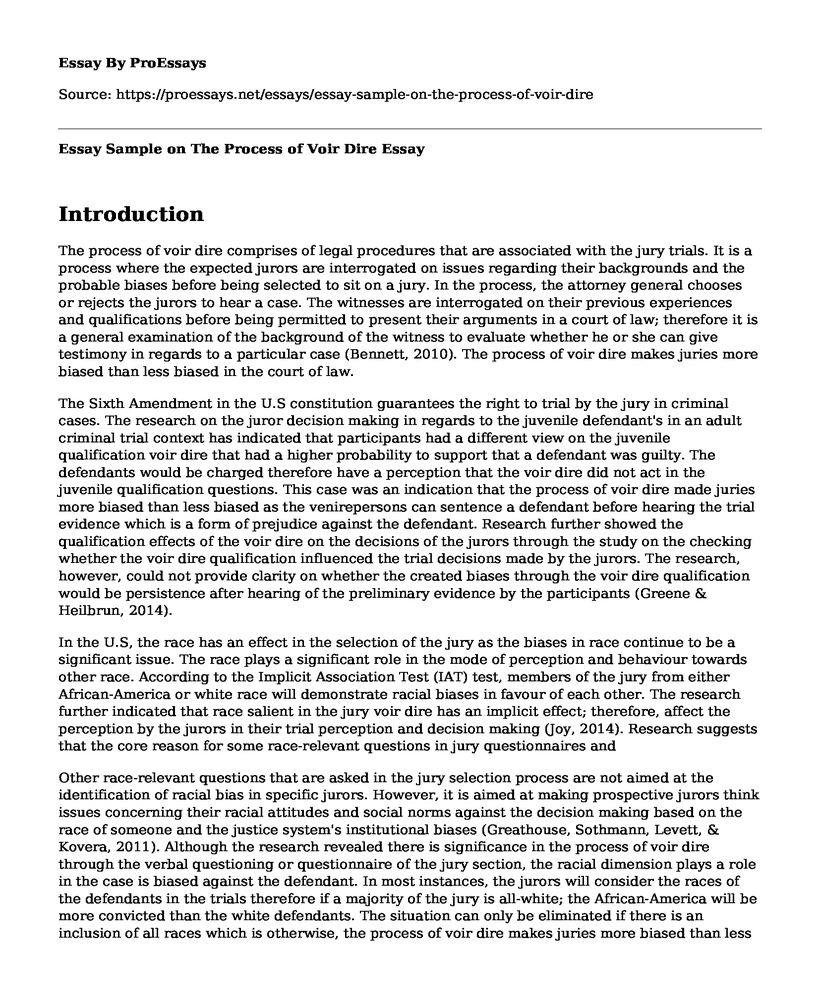Introduction
The process of voir dire comprises of legal procedures that are associated with the jury trials. It is a process where the expected jurors are interrogated on issues regarding their backgrounds and the probable biases before being selected to sit on a jury. In the process, the attorney general chooses or rejects the jurors to hear a case. The witnesses are interrogated on their previous experiences and qualifications before being permitted to present their arguments in a court of law; therefore it is a general examination of the background of the witness to evaluate whether he or she can give testimony in regards to a particular case (Bennett, 2010). The process of voir dire makes juries more biased than less biased in the court of law.
The Sixth Amendment in the U.S constitution guarantees the right to trial by the jury in criminal cases. The research on the juror decision making in regards to the juvenile defendant's in an adult criminal trial context has indicated that participants had a different view on the juvenile qualification voir dire that had a higher probability to support that a defendant was guilty. The defendants would be charged therefore have a perception that the voir dire did not act in the juvenile qualification questions. This case was an indication that the process of voir dire made juries more biased than less biased as the venirepersons can sentence a defendant before hearing the trial evidence which is a form of prejudice against the defendant. Research further showed the qualification effects of the voir dire on the decisions of the jurors through the study on the checking whether the voir dire qualification influenced the trial decisions made by the jurors. The research, however, could not provide clarity on whether the created biases through the voir dire qualification would be persistence after hearing of the preliminary evidence by the participants (Greene & Heilbrun, 2014).
In the U.S, the race has an effect in the selection of the jury as the biases in race continue to be a significant issue. The race plays a significant role in the mode of perception and behaviour towards other race. According to the Implicit Association Test (IAT) test, members of the jury from either African-America or white race will demonstrate racial biases in favour of each other. The research further indicated that race salient in the jury voir dire has an implicit effect; therefore, affect the perception by the jurors in their trial perception and decision making (Joy, 2014). Research suggests that the core reason for some race-relevant questions in jury questionnaires and
Other race-relevant questions that are asked in the jury selection process are not aimed at the identification of racial bias in specific jurors. However, it is aimed at making prospective jurors think issues concerning their racial attitudes and social norms against the decision making based on the race of someone and the justice system's institutional biases (Greathouse, Sothmann, Levett, & Kovera, 2011). Although the research revealed there is significance in the process of voir dire through the verbal questioning or questionnaire of the jury section, the racial dimension plays a role in the case is biased against the defendant. In most instances, the jurors will consider the races of the defendants in the trials therefore if a majority of the jury is all-white; the African-America will be more convicted than the white defendants. The situation can only be eliminated if there is an inclusion of all races which is otherwise, the process of voir dire makes juries more biased than less biased.
Reference
Bennett, M. W. (2010). Unraveling the Gordian knot of implicit bias in jury selection: The problems of judge-dominated voir dire, the failed promise of Batson, and proposed solutions. Harv. L. & Pol'y Rev., 4, 149.
Greathouse, S. M., Sothmann, F. C., Levett, L. M., & Kovera, M. B. (2011). The potentially biasing effects of voir dire in juvenile waiver cases. Law and human behaviour, 35(6), 427-439.Greene, E. & Heilbrun, K. (2014).
Wrightsman's psychology and the legal system (8th ed.). Belmont, CA: Wadsworth, Cengage Learning.
Joy, P. A. (2014). Race matters in jury selection. Nw. UL Rev. Online, 109, 180.
Cite this page
Essay Sample on The Process of Voir Dire . (2022, Nov 01). Retrieved from https://proessays.net/essays/essay-sample-on-the-process-of-voir-dire
If you are the original author of this essay and no longer wish to have it published on the ProEssays website, please click below to request its removal:
- Assignment Example on Communication Styles
- Methods of Communication in the Organization Essay Example
- Essay Sample on Fourteenth Amendment and Homeland Security
- Essay Example on Gun Control: A Test of American Liberalism?
- Justice: Punishing Wrong and Upholding Right for a Just Society - Essay Sample
- Freddie's Story: The Impact of Negative Communication - Essay Sample
- Free Report Example on Communication Challenge







